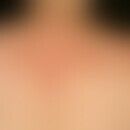Synonym(s)
HistoryThis section has been translated automatically.
Kaposi, 1872; Robert W. Goltz and Robert J.Gorlin, 1960.
Note: Although Gorlin described many syndromes, several of which received his name, none is so closely associated with his name as the nevoid basal cell carcinoma syndrome.
DefinitionThis section has been translated automatically.
Nevoid basal cell carcinoma syndrome, also known as Goltz-Gorlin syndrome, is an autosomal-dominantly inherited multisystem disease characterized by the occurrence of numerous basal cell carcinomas at an early age and multiple other malformations, particularly of the skeletal system, the CNS, the urogenital system and the heart.
Leading symptoms are:
- (prematurely developing) basal cell carcinomas
- jaw cysts
- pits
- Calcifications of the falx cerebri and
- medulloblastomas.
You might also be interested in
Occurrence/EpidemiologyThis section has been translated automatically.
Prevalence (Europe) about 1/57,000 - 1:256,000 patients. It is lower in East Asia, where it is between 1:235,800 and 1:13,939,393.
In up to 40% of cases, the family history is negative, so that a correspondingly high rate of new mutations can be assumed.
EtiopathogenesisThis section has been translated automatically.
Autosomal dominant inheritance with incomplete penetrance of mutations of the gene loci 9q22.3(PTCH1 tumor suppressor gene), 9q31 and 1p32 (see below Hedgehog signaling pathway).
The autosomal dominant inherited nevoid basal cell carcinoma syndrome (BCNS) can be caused by mutations in 3 different genes:
- PTCH1 gene (PTCH = tumor suppressor gene, 601309) on chromosome 9q22
- PTCH2 gene (603673) on chromosome 1p32
- SUFU gene (607035) on chromosome 10q24-q25.
Somatic mutations in the PTCH2 gene have also been identified in solitary basal cell carcinoma (605462) and medulloblastoma (155255). Both malignancies are characteristics of the nevoid basal cell carcinoma syndrome.
More than 70 germline mutations have now been found in patients with Gorlin-Goltz syndrome. The PTCH gene encodes a transmembrane protein (PTCH) that acts as a receptor in the Sonic-Hedgehog signaling cascade. This activation usually occurs through the binding of SHH to PTCH. This removes the inhibitory effect of PTCH on the cell membrane protein Smoothened (SMO). This allows signals to be transmitted into the intercellular space up to the cell nucleus. In the cell nucleus, further activation of transcription factors (e.g. Gli1 = glioma-associated onogenic homolog) occurs, which in turn induce genes in the cell nucleus that lead to cell cycle progression and cell proliferation (Hübner L 2014).
Linear basal cell carcinomas: Basal cell carcinomas in a linear arrangement are regarded as a special form of nevoid basal cell carcinoma syndrome (Gorlin-Goltz syndrome).
ManifestationThis section has been translated automatically.
Can occur at any age. Mostly occurring in early adulthood.
ClinicThis section has been translated automatically.
Skin: Multiple, dense basal cell carcinomas (mostly nodulo-ulcerous type, partly pigmented) mainly on the face, but also on the trunk and extremities. First basal cell carcinomas may appear before the age of 20. Slow growth; tumour size may remain stationary for years. Possibly sudden, expansive growth of individual tumors accompanied by ulceration and destruction. In almost 90% of cases dimpled palmoplantar keratoses (pits) are found. Lipomas, epidermal cysts and milia can also be found on the skin.
Skeletal system: Odontogenic jaw cysts, rib cysts, dental malformations, forked ribs, spina bifida, scoliosis, frontal humps, widened nasal bridge, shortened metacarpal bones (4th and 5th rays), syndactyls.
CNS: Macrocephaly, agenesis of the corpus callosum (10% of cases), calcifications of the falx cerebri, cataract, congenital amaurosis, facultative mental retardation; 5% of affected individuals have medulloblastoma of the cerebellum in childhood.
Genital tract: Optional calcifications of the ovary, ovarian fibroids. In male patients, facultative hypogonadism.
Casuistics compiled from the literature:
- Gorlin and Goltz (1960) described a familial syndrome with multiple nevoid basal cell epitheliomas, maxillary cysts, and bifid rib. The inheritance was autosomal dominant.
- Herzberg and Wiskemann (1963) described what they called the "fifth phakomatosis," a basal cell nevus syndrome with medulloblastoma. They reported on a family in which both the father and son had basal cell carcinomas, with the son also having medulloblastoma and congenital thoracic scoliosis.
- Cawson and Kerr (1964) described a syndrome with mandibular cysts, basal cell carcinomas, and skeletal abnormalities. One of the patients also suffered from astrocytoma with severe hydrocephalus. Other features included pits on the palms and soles.
- Lile et al (1968) observed 4 cases in 3 generations of one family. Two of the patients had a short terminal phalanx of the thumb.
- Berlin et al (1966) observed ovarian carcinoma associated with this syndrome.
- Holubar et al (1970) found basal cell epitheliomas in multiple palmar pits in an 8-year-old girl with BCNS.
- Schwartz (1978) noted hamartomatous polyps of the stomach and mesenteric cysts as features of basal cell nevus syndrome. Totten (1980) observed a large congenital lung cyst occupying the left thoracic cavity in an affected patient.
- Cramer and Niederdellmann (1983) described 9 individuals from 3 families with cerebral gigantism syndrome (117550); 7 of the patients also had signs of nevoid basal cell carcinoma syndrome. In one family, aged father and son had jaw cysts and other signs of nevoid basal cell carcinoma syndrome. A second son suffered from macrocephaly, mild hydrocephalus, intracranial calcifications, and EEG abnormalities.
- Koch et al (2002) described a 13-year-old boy with NBCCS and mesenchymal liver tumor. At the age of 3 years, he had been treated for medulloblastoma by resection and radiation.
DiagnosisThis section has been translated automatically.
- Diagnosis of clinical complications according to Evans:
- Major criteria:
- More than 2 basal cell carcinomas or 1 basal cell carcinoma before LJ 30
- Jaw cysts before the 20th LJ
- Palmare or plantar dimples (> 3)
- Calcification of the falx cerebri
- Medulloblastoma, especially desmoplastic type
- Positive family history (1st degree relatives with BZNS)
- Secondary criteria:
- Congenital skeletal anomalies:
- Split, fused or missing ribs
- Split or fused vertebral bodies
- Frontooccipital head circumference (> 97th percentile, with frontal bumps)
- Cardiac or ovarian fibroids
- Congenital malformation: cleft lip, jaw, palate, polydactyly, cataract, iriscoloboma.
- Congenital skeletal anomalies:
- Major criteria:
Notice! A diagnosis is made when 2 major criteria or 1 major criterion and 2 minor criteria are met.
TherapyThis section has been translated automatically.
External therapyThis section has been translated automatically.
Internal therapyThis section has been translated automatically.
Prophylaxis with acitretin (neotigason) 0.5 mg/kg bw/day p.o.
New studies show good results with pembrolizumab.
LiteratureThis section has been translated automatically.
- Anderson DE et al (1967) The nevoid basal cell carcinoma syndrome. Am J Hum Genet 19: 12-22
- Bale AE (1997) Variable expressivity of patched mutations in flies and humans. (Editorial) Am. J Hum Gene 60: 10-12.
- Berlin NI et al (1966) Basal cell nevus syndrome. Ann.Intern Med 64: 403-421.
- Boutet N et al (2003) Spectrum of PTCH1 mutations in French patients with Gorlin syndrome. J Invest Dermatol 121: 478-481.
- Burgdorf WHC et al (1988) Autosomal dominant genodermatoses and their association with internal carcinomas. Dermatol 39: 413-418
- Cawson R A et al (1964) The syndrome of jaw cysts, basal cell tumours and skeletal anomalies. Proc Roy Soc Med 57: 799-801
- Cramer H et al (1983) Cerebral gigantism associated with jaw cyst basal cell naevoid syndrome in two families. Arch Psychiat Nervenkr 233: 111-124.
- Evans DGR et al (1993) Complications of the naevoid basal cell carcinoma syndrome: results of a population based study. J Med Genet 30: 460-464
- Fink-Puches R et al (1994) Retinoids in the chemoprevention of skin and mucosal tumors. Dermatologist 45: 671-677
- Gorlin RJ, Goltz RW (1960) Multiple nevoid basal-cell epithelioma, jaw cysts and bifid rib. A syndrome. N Engl J Med 262: 908-912
- Happle R (2000) Nonsyndromic type of hereditary multiple basal cell carcinoma. Am J Med Genet 95: 161-163
- Herzberg J J et al (1963) The fifth phakomatosis. Basal cell nevus with familial burden and medulloblastoma. Dermatologica 126: 106-123
- Holubar K et al (1970) Multiple palmar basal cell epitheliomas in basal cell nevus syndrome. Arch Derm 101: 679-682.
- Hübinger L et al (2014) Genodermatoses associated with malignant skin tumors. Dermatologist 65: 527-535
- Kaposi M (1872) Idiopathic multiple pigmentary sarcoma of the skin. Archives of dermatology and syphilis (Prague) 4: 265-273.
- Koch CA et al (2002) Two-hit model for tumorigenesis of nevoid basal cell carcinoma (Gorlin) syndrome-associated hepatic mesenchymal tumor. (Letter) Am J Med Genet 109: 74-76.
- LeSueur BW et al (2003) Axillary basal cell carcinoma. Dermatol Surg 29: 1105-1108.
- Lile HA et a. (1999) The basal cell nevus syndrome. Am J Roentgen Radium Ther. Nucl Med 103: 214-217.
- Linß G, Burhardt E, Reis A (2000) Correlation between patched gene mutation and clinical presentation in basal cell nevus syndrome (Gorlin syndrome). In: Plettenberg A, Meigel WN, Moll I (eds) Dermatology on the threshold of the new millennium. Springer, Berlin Heidelberg New York, pp. 559-561.
- Mirowski GW (2002) Nevoid basal cell carcinoma syndrome. J Am Acad Dermatol 43: 1092-1093
- Reifenberger J (2004) Hereditary tumor syndromes. Dermatologist 55: 942-951
- Schwartz,RA (1994) Basal-cell nevus syndrome and gastrointestinal polyposis. (Letter) New Eng J Med 299: 49
- Schulz-Butulis BA et al (2000) Nevoid basal cell carcinoma syndrome and non-Hodgkin's lymphoma. Cutis 66: 35-38
- Stockfleth E (2002) Successful treatment of basal cell carcinomas in a nevoid basal cell carcinoma syndrome with topical 5% imiquimod. Eur J Dermatol 12: 569-572
Incoming links (18)
Basal cell carcinoma syndrome naevoides; Basal cell nevus syndrome; Basocellular carcinoma naevoides; Bazex-dupré-christol syndrome; Chromosome 9; Epidermal cyst; Familial cancer syndrome; Hedgehog signal path; Hermans-grosfeld-spaas-valk disease; Milia; ... Show allOutgoing links (9)
Basal cell carcinoma (overview); Cryosurgery; Curettage; Excision; Hedgehog signal path; Palmoplantar keratoses (overview); Pembrolizumab; PTCH1 Gene; Transcription factors;Disclaimer
Please ask your physician for a reliable diagnosis. This website is only meant as a reference.




